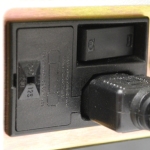“Carbon black, also called charcoal black lamp black, pigment black, soot or black carbon, is a fine particle carbon pigment obtained as soot from the incomplete combustion of many different types of organic materials, such as natural gas, or oil. Carbon black is usually a fine, soft, black powder. It is very stable and unaffected by light, acids and alkalis. It is commonly used in printing and lithograph inks and in Chinese ink sticks. In industry, carbon black is used as a filtration material and a filler /pigment in coatings, rubber, plastics, paints, carbon paper, and crayons. Continue reading
Category Archives: LabScan XE
Can you explain the LabScan XE 0:45 inverted geometry?
FAQ: “Straight from the LSXE Pro-forma, the LabScan XE sample ports are described as:
Port Insert, 3-mm illuminated area; 5-mm measured area
Port Insert, 6-mm illuminated area; 10-mm measured area
Port Insert, 13-mm illuminated area; 17-mm measured area
Port Insert, 25-mm illuminated area; 30-mm measured area
Port Insert, 44-mm illuminated area; 50-mm measured area
I always thought that the measured area was smaller than the illuminated area. Have the illuminated/measured area in the Pro-forma been transposed? Seems like it!”
Independent Test Lab for DDG Color of Dried Distillers Grain?
FAQ: “Do you know of a test lab for DDG Color of Dried Distillers Grain?
DDG stands for ‘Dried Distillers Grain”. While its origins are based on evaluation of the residual protein content of wheat and corn for cattle feed that had been used in the distillation of whiskey, bourbon and spirits, it has moved on from distillers to serve the same purpose for the biofuels industry. Continue reading
Directional Instruments
HunterLab manufactures bench top instruments with two different geometry types: directional 45/0 (or 0/45) and diffuse sphere instruments, as discussed in a previous blog note. A 45/0 directional instrument illuminates the sample at a 45˚ angle from the sample surface and the detector is located 0˚ in line perpendicular to the sample surface. The inverse, 0˚ illumination and detection at 45˚, can also be used and yields equivalent measurements. The MiniScan EZ and ColorFlex EZ instruments are 45/0 instruments and the LabScan XE is a 0/45 instrument. Continue reading
Measuring small sample quantities with ColorFlex
FAQ: “My customer has a ColorFlex 45:0 LAV and needs to measure a very small amount of sample in a cup. Do we have a sample cup for small quantities?” Continue reading
How do I measure the color of semi-solid materials?
One thing to keep in mind when measuring creams, gels, pastes, and other semi-solid materials is to maintain a consistent sample thickness. One option is to “sandwich” a fixed quanity of your semi-solid material in a suitable clear-bottomed container, so that it can be placed at the port for measurement. Continue reading
What Fuse Protection is in place with HunterLab Instruments?
All HunterLab instruments have fuses built into the main circuitry to protect the instrument against unusual and unexpected changes in voltage that could damage the electrical components.
Can Power Supplies in HunterLab Instruments be used everywhere?
 FAQ: “We need to take our LabScan XE instrument to Germany for some plant trial testing. Our machine is a US spectrophotometer 110v unit and, obviously, the power supply in Germany is 220v. The label on the back of the instrument says ‘110v-220v’, which sounds a little ambiguous to me. Do we need a voltage transformer or can we get away with only using a plug adapter (does not step down current from 220v, only changes plug shape)? We don’t want to ruin our baby!” Continue reading
FAQ: “We need to take our LabScan XE instrument to Germany for some plant trial testing. Our machine is a US spectrophotometer 110v unit and, obviously, the power supply in Germany is 220v. The label on the back of the instrument says ‘110v-220v’, which sounds a little ambiguous to me. Do we need a voltage transformer or can we get away with only using a plug adapter (does not step down current from 220v, only changes plug shape)? We don’t want to ruin our baby!” Continue reading



